Blamescapes and Superflattenings
-
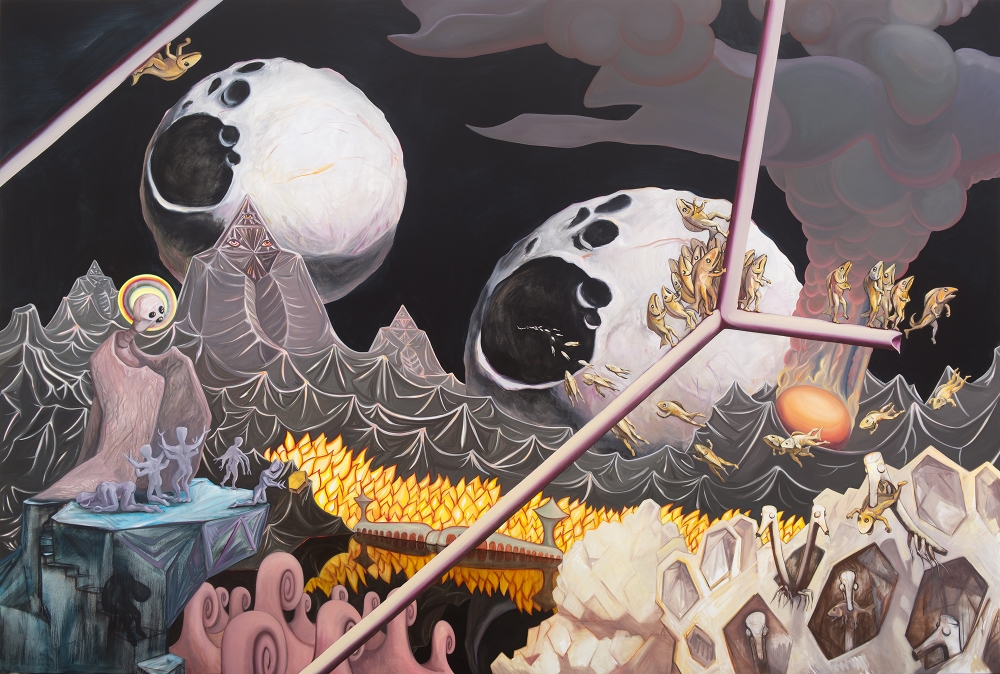
Evil Message or the Last Sermon of Stringy Meatwinger. 2018. Oil on canvas, 380 cm x 550 cm. LED display 30 cm x 130 cm. Photo: Valdis Jansons
The bureaucratization of the mind and trust in omnipotence teachings that refine illusions about leaders endowed with a mystical ability to pull out benefits of the Horn of Plenty inexhaustibly. Their own sleepy carelessness against the important, which made “professionals” more powerful than they should be. Their compromises. And what now...Reflection is the courage to question the truthfulness of knowledge and the space of its goals – it can be said not only by the philosopher Martin Heidegger but also by others, in particular context with Heidegger's intelligent sigh, that such "thinking is not necessary for everyone, and can be ineffective or even just unbearable". Miķelis Fišers new work exhibition can be read as the option that draws the reflection process: with a silence in almost uncontrollable outbursts in the series of colored pencil drawings or surrealistic frottages; with a "noisy" silence of almost unbearable, Dadaistic cries (voice by the artist), which stay “undressed“ even in the modern insulation material of The Little Wailing Wall (Floor II). And with the detailed narratives, full of illustrative material in large-scale paintings and with the precedent of narrative transformation from the visual matter to the textual one: the story, in its verbal intensity exceeding the painting potential, emanates from the painting as a "red thread" on the LED display (Floor I).
The observer from the distance can quite easily spot the extravaganza in Miķelis Fišers newest work. There are large paintings, new esoteric characters, and storylines, immersive and psychologically absorbing environments behind the figurative title “Blamescapes and Superflattenings”. There is a persistent narrative of morality in his work, though Miķelis Fišers chooses the language full of unscientific substances. Of all bodies of knowledge, he chooses knowledge without status and techniques of alternative criticality, which confirms the basic impact of science through deliberate unscientificity. With a power and with a weakness “Blamescapes and Superflattenings” challenges Heidegger's definition of the modern age: the world conceived and grasped as picture, and human beings transformed into subjectum, t.i., into the standard of everything existing. The technical clarity of the form and the message liked by the artist serves to provoke a doubt towards the "well-known" and to remind that the clearness about the world is not a consumer product that can be easily used. Miķelis Fišers purposefully uses the power of the art itself—it's being different from politics, philosophy, religion, science and esotericism, but trying to be in a conditional spatial point where the individual details of constructed fields lose their distinctions through their sharp edges. Striving to define its historical difference from art that was created before it, contemporary art has become careless in relation to the rest of the world. It’s starting to liken to everything else. Miķelis Fišers has taken this into consideration. He relies on and uses the distinctiveness of art as a point of departure of his conceptual work.
Artworks presented in the exhibition by Miķelis Fišers: “The Evil Message or the Last Sermon of Stringy Meatwinger”, “Sunrise at the Wastelands of Madness. Padites”, “The Abandoned Paradise” (all 2018, architecture by Roberta Fišere), Frottages of Polygonal Surfaces (2016), and “The Little Wailing Wall” (2018, sound together with ERROR). The full-length documentary by Mārtiņš Grauds ”Forging Condors” (2018) presented in the exhibition will help to lead to Miķelis Fišers art and personality.
Curator Inga Šteimane.(1) Martin Heidegger. Holzwege. Frankfurt am Main: Vittorio Klostermann, 1980. From: M. Heidegers. Malkasceļi. Rīga, Intelekts, 1998, 58.p., 71.p.
-
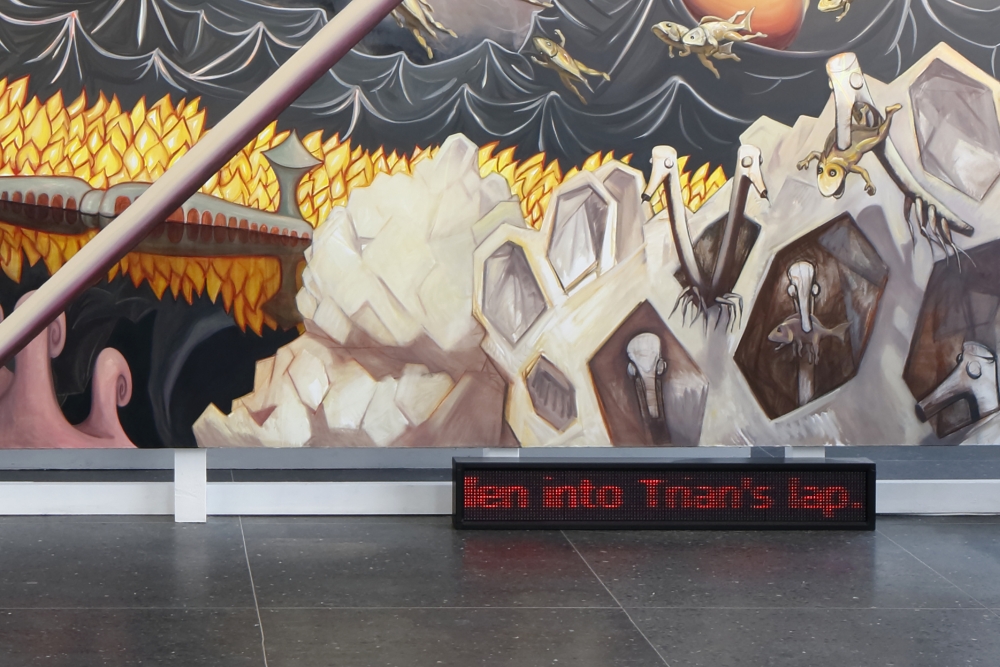
In spite of efforts by Trian the Great to calm down and regain control over the meta-situation, the performance of the Imitators was increasing with each passing moment. Materialization of Holey Moon's frightening twin was now unstoppable. Total despair overwhelmed Flatheads. For eons they had followed and observed the Laws and Teachings of Stringy Meatwinger. But now the obtuse Flatheads had to witness the consequences of Trian's fateful negligence... their nostrils already sensing pungent stench emanating from a burning Orbital Lighting Egg that had fallen into Trian's lap. Flatheads finally realized they will not be destined to experience the promised eternal bowing in misty wetlands of the Paradise. "Oh, I overdid again," Trian thought chaotically. Is this really the end of it all? Of Skeiners' hexagonal duckings? Of newly built and elegant deworming hangars? Of clacking howls of Fish People during layered sunsets... and himself, the almighty Trian, the Materializator of Ameliorated Worlds. Wayward Rare-earth Retflesh, whose swelling, budding and blossoming had been eagerly awaited by whole of Sweater's habitat, was stunned feeling the imminent calamity, purpling insecurely. And now, Fish People did what Ancient Scrolls of The Elders of Fish People commanded: "On the day when another frightening moon will emerge, You shall climb the highest tree; Then you will let go and fly, with divinely beautiful thoughts, into the Blackest Hole. There, a new Antiworld will await you in its dark radiance". Above and below it all, senseless prayers and teachings of Stringy Meatwinger loudly echoed in complex structures of the Skeiners, like a lonely goat's song in a mountain cave.
The bureaucratization of the mind and trust in omnipotence teachings that refine illusions about leaders endowed with a mystical ability to pull out benefits of the Horn of Plenty inexhaustibly. Their own sleepy carelessness against the important, which made “professionals” more powerful than they should be. Their compromises. And what now...Reflection is the courage to question the truthfulness of knowledge and the space of its goals – it can be said not only by the philosopher Martin Heidegger but also by others, in particular context with Heidegger's intelligent sigh, that such "thinking is not necessary for everyone, and can be ineffective or even just unbearable". Miķelis Fišers new work exhibition can be read as the option that draws the reflection process: with a silence in almost uncontrollable outbursts in the series of colored pencil drawings or surrealistic frottages; with a "noisy" silence of almost unbearable, Dadaistic cries (voice by the artist), which stay “undressed“ even in the modern insulation material of The Little Wailing Wall (Floor II). And with the detailed narratives, full of illustrative material in large-scale paintings and with the precedent of narrative transformation from the visual matter to the textual one: the story, in its verbal intensity exceeding the painting potential, emanates from the painting as a "red thread" on the LED display (Floor I).
The observer from the distance can quite easily spot the extravaganza in Miķelis Fišers newest work. There are large paintings, new esoteric characters, and storylines, immersive and psychologically absorbing environments behind the figurative title “Blamescapes and Superflattenings”. There is a persistent narrative of morality in his work, though Miķelis Fišers chooses the language full of unscientific substances. Of all bodies of knowledge, he chooses knowledge without status and techniques of alternative criticality, which confirms the basic impact of science through deliberate unscientificity. With a power and with a weakness “Blamescapes and Superflattenings” challenges Heidegger's definition of the modern age: the world conceived and grasped as picture, and human beings transformed into subjectum, t.i., into the standard of everything existing. The technical clarity of the form and the message liked by the artist serves to provoke a doubt towards the "well-known" and to remind that the clearness about the world is not a consumer product that can be easily used. Miķelis Fišers purposefully uses the power of the art itself—it's being different from politics, philosophy, religion, science and esotericism, but trying to be in a conditional spatial point where the individual details of constructed fields lose their distinctions through their sharp edges. Striving to define its historical difference from art that was created before it, contemporary art has become careless in relation to the rest of the world. It’s starting to liken to everything else. Miķelis Fišers has taken this into consideration. He relies on and uses the distinctiveness of art as a point of departure of his conceptual work.
Artworks presented in the exhibition by Miķelis Fišers: “The Evil Message or the Last Sermon of Stringy Meatwinger”, “Sunrise at the Wastelands of Madness. Padites”, “The Abandoned Paradise” (all 2018, architecture by Roberta Fišere), Frottages of Polygonal Surfaces (2016), and “The Little Wailing Wall” (2018, sound together with ERROR). The full-length documentary by Mārtiņš Grauds ”Forging Condors” (2018) presented in the exhibition will help to lead to Miķelis Fišers art and personality.
Curator Inga Šteimane.(1) Martin Heidegger. Holzwege. Frankfurt am Main: Vittorio Klostermann, 1980. From: M. Heidegers. Malkasceļi. Rīga, Intelekts, 1998, 58.p., 71.p.
-
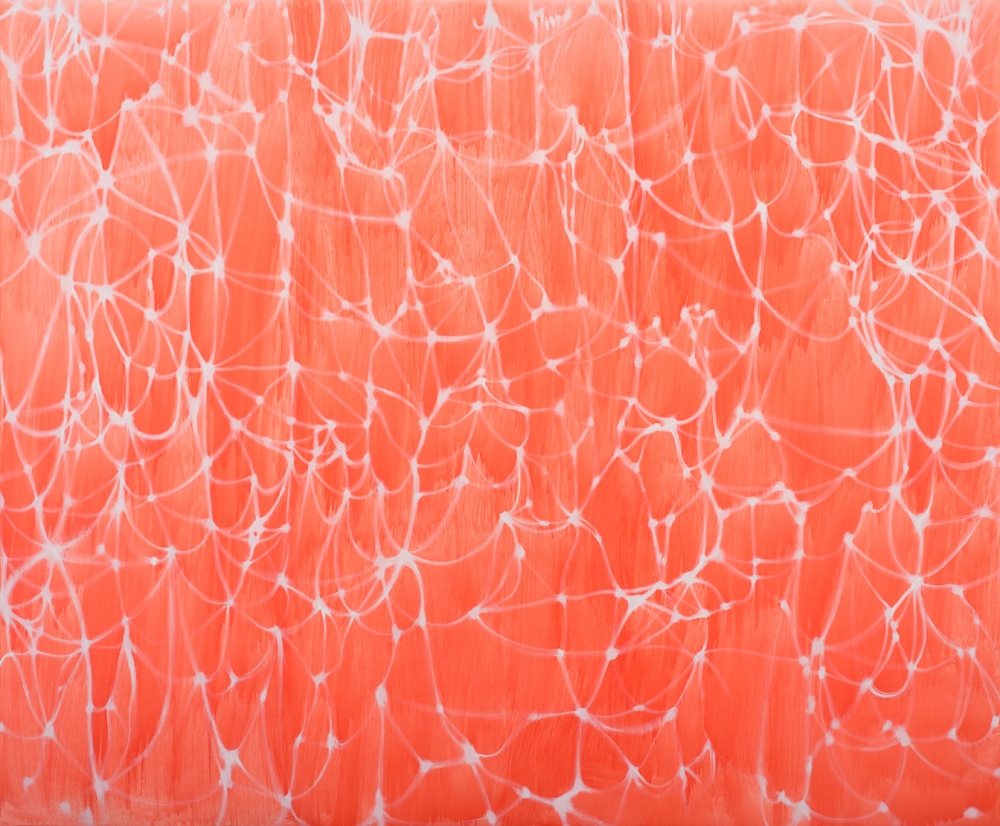
Abandoned Paradise. 2018. Oil on canvas. 380 cm x 460 cm. Photo: Valdis Jansons
The bureaucratization of the mind and trust in omnipotence teachings that refine illusions about leaders endowed with a mystical ability to pull out benefits of the Horn of Plenty inexhaustibly. Their own sleepy carelessness against the important, which made “professionals” more powerful than they should be. Their compromises. And what now...Reflection is the courage to question the truthfulness of knowledge and the space of its goals – it can be said not only by the philosopher Martin Heidegger but also by others, in particular context with Heidegger's intelligent sigh, that such "thinking is not necessary for everyone, and can be ineffective or even just unbearable". Miķelis Fišers new work exhibition can be read as the option that draws the reflection process: with a silence in almost uncontrollable outbursts in the series of colored pencil drawings or surrealistic frottages; with a "noisy" silence of almost unbearable, Dadaistic cries (voice by the artist), which stay “undressed“ even in the modern insulation material of The Little Wailing Wall (Floor II). And with the detailed narratives, full of illustrative material in large-scale paintings and with the precedent of narrative transformation from the visual matter to the textual one: the story, in its verbal intensity exceeding the painting potential, emanates from the painting as a "red thread" on the LED display (Floor I).
The observer from the distance can quite easily spot the extravaganza in Miķelis Fišers newest work. There are large paintings, new esoteric characters, and storylines, immersive and psychologically absorbing environments behind the figurative title “Blamescapes and Superflattenings”. There is a persistent narrative of morality in his work, though Miķelis Fišers chooses the language full of unscientific substances. Of all bodies of knowledge, he chooses knowledge without status and techniques of alternative criticality, which confirms the basic impact of science through deliberate unscientificity. With a power and with a weakness “Blamescapes and Superflattenings” challenges Heidegger's definition of the modern age: the world conceived and grasped as picture, and human beings transformed into subjectum, t.i., into the standard of everything existing. The technical clarity of the form and the message liked by the artist serves to provoke a doubt towards the "well-known" and to remind that the clearness about the world is not a consumer product that can be easily used. Miķelis Fišers purposefully uses the power of the art itself—it's being different from politics, philosophy, religion, science and esotericism, but trying to be in a conditional spatial point where the individual details of constructed fields lose their distinctions through their sharp edges. Striving to define its historical difference from art that was created before it, contemporary art has become careless in relation to the rest of the world. It’s starting to liken to everything else. Miķelis Fišers has taken this into consideration. He relies on and uses the distinctiveness of art as a point of departure of his conceptual work.
Artworks presented in the exhibition by Miķelis Fišers: “The Evil Message or the Last Sermon of Stringy Meatwinger”, “Sunrise at the Wastelands of Madness. Padites”, “The Abandoned Paradise” (all 2018, architecture by Roberta Fišere), Frottages of Polygonal Surfaces (2016), and “The Little Wailing Wall” (2018, sound together with ERROR). The full-length documentary by Mārtiņš Grauds ”Forging Condors” (2018) presented in the exhibition will help to lead to Miķelis Fišers art and personality.
Curator Inga Šteimane.(1) Martin Heidegger. Holzwege. Frankfurt am Main: Vittorio Klostermann, 1980. From: M. Heidegers. Malkasceļi. Rīga, Intelekts, 1998, 58.p., 71.p.
-
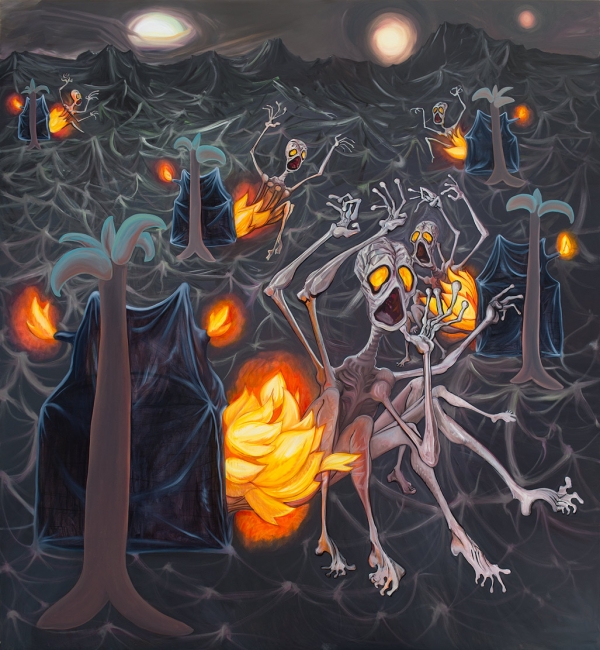
Sunrise at the Wastelands of Maddness. 2018. Oil on canvas. 410 cm x 380 cm. Photo: Valdis Jansons
The bureaucratization of the mind and trust in omnipotence teachings that refine illusions about leaders endowed with a mystical ability to pull out benefits of the Horn of Plenty inexhaustibly. Their own sleepy carelessness against the important, which made “professionals” more powerful than they should be. Their compromises. And what now...Reflection is the courage to question the truthfulness of knowledge and the space of its goals – it can be said not only by the philosopher Martin Heidegger but also by others, in particular context with Heidegger's intelligent sigh, that such "thinking is not necessary for everyone, and can be ineffective or even just unbearable". Miķelis Fišers new work exhibition can be read as the option that draws the reflection process: with a silence in almost uncontrollable outbursts in the series of colored pencil drawings or surrealistic frottages; with a "noisy" silence of almost unbearable, Dadaistic cries (voice by the artist), which stay “undressed“ even in the modern insulation material of The Little Wailing Wall (Floor II). And with the detailed narratives, full of illustrative material in large-scale paintings and with the precedent of narrative transformation from the visual matter to the textual one: the story, in its verbal intensity exceeding the painting potential, emanates from the painting as a "red thread" on the LED display (Floor I).
The observer from the distance can quite easily spot the extravaganza in Miķelis Fišers newest work. There are large paintings, new esoteric characters, and storylines, immersive and psychologically absorbing environments behind the figurative title “Blamescapes and Superflattenings”. There is a persistent narrative of morality in his work, though Miķelis Fišers chooses the language full of unscientific substances. Of all bodies of knowledge, he chooses knowledge without status and techniques of alternative criticality, which confirms the basic impact of science through deliberate unscientificity. With a power and with a weakness “Blamescapes and Superflattenings” challenges Heidegger's definition of the modern age: the world conceived and grasped as picture, and human beings transformed into subjectum, t.i., into the standard of everything existing. The technical clarity of the form and the message liked by the artist serves to provoke a doubt towards the "well-known" and to remind that the clearness about the world is not a consumer product that can be easily used. Miķelis Fišers purposefully uses the power of the art itself—it's being different from politics, philosophy, religion, science and esotericism, but trying to be in a conditional spatial point where the individual details of constructed fields lose their distinctions through their sharp edges. Striving to define its historical difference from art that was created before it, contemporary art has become careless in relation to the rest of the world. It’s starting to liken to everything else. Miķelis Fišers has taken this into consideration. He relies on and uses the distinctiveness of art as a point of departure of his conceptual work.
Artworks presented in the exhibition by Miķelis Fišers: “The Evil Message or the Last Sermon of Stringy Meatwinger”, “Sunrise at the Wastelands of Madness. Padites”, “The Abandoned Paradise” (all 2018, architecture by Roberta Fišere), Frottages of Polygonal Surfaces (2016), and “The Little Wailing Wall” (2018, sound together with ERROR). The full-length documentary by Mārtiņš Grauds ”Forging Condors” (2018) presented in the exhibition will help to lead to Miķelis Fišers art and personality.
Curator Inga Šteimane.(1) Martin Heidegger. Holzwege. Frankfurt am Main: Vittorio Klostermann, 1980. From: M. Heidegers. Malkasceļi. Rīga, Intelekts, 1998, 58.p., 71.p.
-
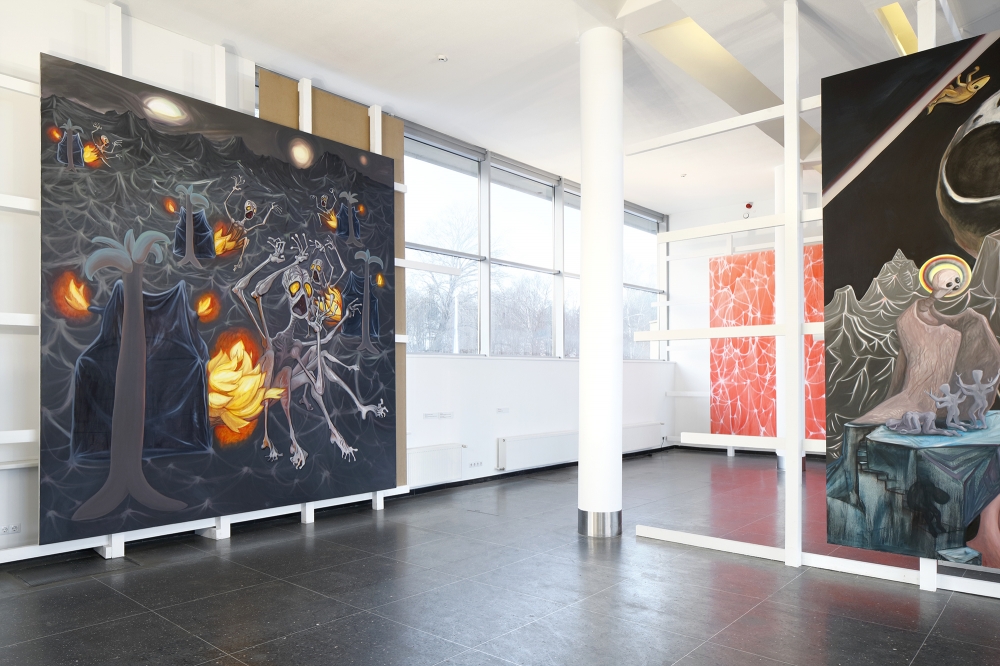
Photo: Ansis Starks
The bureaucratization of the mind and trust in omnipotence teachings that refine illusions about leaders endowed with a mystical ability to pull out benefits of the Horn of Plenty inexhaustibly. Their own sleepy carelessness against the important, which made “professionals” more powerful than they should be. Their compromises. And what now...Reflection is the courage to question the truthfulness of knowledge and the space of its goals – it can be said not only by the philosopher Martin Heidegger but also by others, in particular context with Heidegger's intelligent sigh, that such "thinking is not necessary for everyone, and can be ineffective or even just unbearable". Miķelis Fišers new work exhibition can be read as the option that draws the reflection process: with a silence in almost uncontrollable outbursts in the series of colored pencil drawings or surrealistic frottages; with a "noisy" silence of almost unbearable, Dadaistic cries (voice by the artist), which stay “undressed“ even in the modern insulation material of The Little Wailing Wall (Floor II). And with the detailed narratives, full of illustrative material in large-scale paintings and with the precedent of narrative transformation from the visual matter to the textual one: the story, in its verbal intensity exceeding the painting potential, emanates from the painting as a "red thread" on the LED display (Floor I).
The observer from the distance can quite easily spot the extravaganza in Miķelis Fišers newest work. There are large paintings, new esoteric characters, and storylines, immersive and psychologically absorbing environments behind the figurative title “Blamescapes and Superflattenings”. There is a persistent narrative of morality in his work, though Miķelis Fišers chooses the language full of unscientific substances. Of all bodies of knowledge, he chooses knowledge without status and techniques of alternative criticality, which confirms the basic impact of science through deliberate unscientificity. With a power and with a weakness “Blamescapes and Superflattenings” challenges Heidegger's definition of the modern age: the world conceived and grasped as picture, and human beings transformed into subjectum, t.i., into the standard of everything existing. The technical clarity of the form and the message liked by the artist serves to provoke a doubt towards the "well-known" and to remind that the clearness about the world is not a consumer product that can be easily used. Miķelis Fišers purposefully uses the power of the art itself—it's being different from politics, philosophy, religion, science and esotericism, but trying to be in a conditional spatial point where the individual details of constructed fields lose their distinctions through their sharp edges. Striving to define its historical difference from art that was created before it, contemporary art has become careless in relation to the rest of the world. It’s starting to liken to everything else. Miķelis Fišers has taken this into consideration. He relies on and uses the distinctiveness of art as a point of departure of his conceptual work.
Artworks presented in the exhibition by Miķelis Fišers: “The Evil Message or the Last Sermon of Stringy Meatwinger”, “Sunrise at the Wastelands of Madness. Padites”, “The Abandoned Paradise” (all 2018, architecture by Roberta Fišere), Frottages of Polygonal Surfaces (2016), and “The Little Wailing Wall” (2018, sound together with ERROR). The full-length documentary by Mārtiņš Grauds ”Forging Condors” (2018) presented in the exhibition will help to lead to Miķelis Fišers art and personality.
Curator Inga Šteimane.(1) Martin Heidegger. Holzwege. Frankfurt am Main: Vittorio Klostermann, 1980. From: M. Heidegers. Malkasceļi. Rīga, Intelekts, 1998, 58.p., 71.p.
-
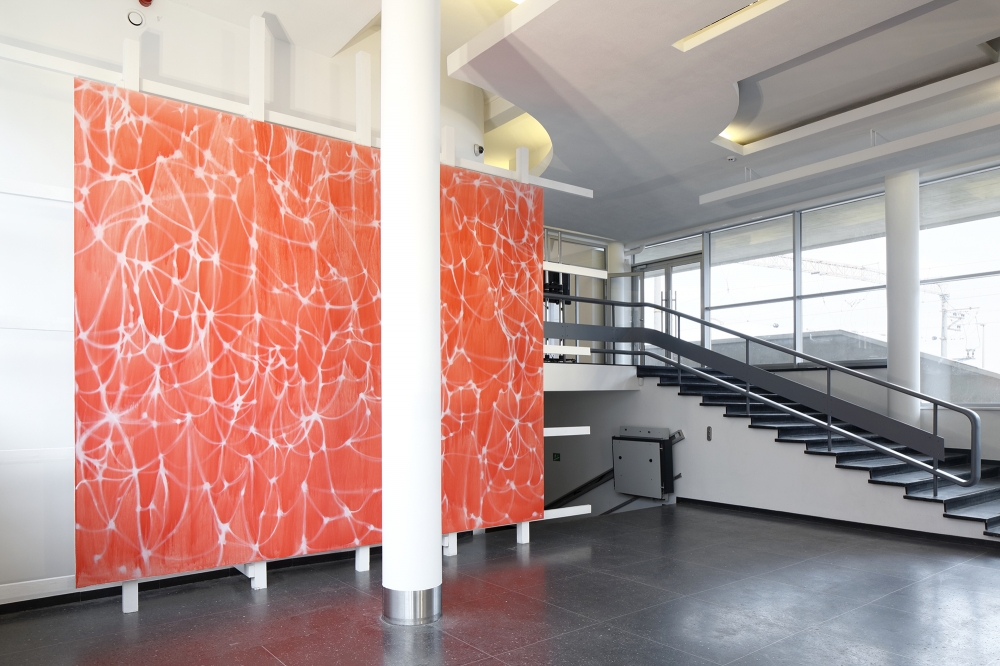
Photo: Ansis Starks
The bureaucratization of the mind and trust in omnipotence teachings that refine illusions about leaders endowed with a mystical ability to pull out benefits of the Horn of Plenty inexhaustibly. Their own sleepy carelessness against the important, which made “professionals” more powerful than they should be. Their compromises. And what now...Reflection is the courage to question the truthfulness of knowledge and the space of its goals – it can be said not only by the philosopher Martin Heidegger but also by others, in particular context with Heidegger's intelligent sigh, that such "thinking is not necessary for everyone, and can be ineffective or even just unbearable". Miķelis Fišers new work exhibition can be read as the option that draws the reflection process: with a silence in almost uncontrollable outbursts in the series of colored pencil drawings or surrealistic frottages; with a "noisy" silence of almost unbearable, Dadaistic cries (voice by the artist), which stay “undressed“ even in the modern insulation material of The Little Wailing Wall (Floor II). And with the detailed narratives, full of illustrative material in large-scale paintings and with the precedent of narrative transformation from the visual matter to the textual one: the story, in its verbal intensity exceeding the painting potential, emanates from the painting as a "red thread" on the LED display (Floor I).
The observer from the distance can quite easily spot the extravaganza in Miķelis Fišers newest work. There are large paintings, new esoteric characters, and storylines, immersive and psychologically absorbing environments behind the figurative title “Blamescapes and Superflattenings”. There is a persistent narrative of morality in his work, though Miķelis Fišers chooses the language full of unscientific substances. Of all bodies of knowledge, he chooses knowledge without status and techniques of alternative criticality, which confirms the basic impact of science through deliberate unscientificity. With a power and with a weakness “Blamescapes and Superflattenings” challenges Heidegger's definition of the modern age: the world conceived and grasped as picture, and human beings transformed into subjectum, t.i., into the standard of everything existing. The technical clarity of the form and the message liked by the artist serves to provoke a doubt towards the "well-known" and to remind that the clearness about the world is not a consumer product that can be easily used. Miķelis Fišers purposefully uses the power of the art itself—it's being different from politics, philosophy, religion, science and esotericism, but trying to be in a conditional spatial point where the individual details of constructed fields lose their distinctions through their sharp edges. Striving to define its historical difference from art that was created before it, contemporary art has become careless in relation to the rest of the world. It’s starting to liken to everything else. Miķelis Fišers has taken this into consideration. He relies on and uses the distinctiveness of art as a point of departure of his conceptual work.
Artworks presented in the exhibition by Miķelis Fišers: “The Evil Message or the Last Sermon of Stringy Meatwinger”, “Sunrise at the Wastelands of Madness. Padites”, “The Abandoned Paradise” (all 2018, architecture by Roberta Fišere), Frottages of Polygonal Surfaces (2016), and “The Little Wailing Wall” (2018, sound together with ERROR). The full-length documentary by Mārtiņš Grauds ”Forging Condors” (2018) presented in the exhibition will help to lead to Miķelis Fišers art and personality.
Curator Inga Šteimane.(1) Martin Heidegger. Holzwege. Frankfurt am Main: Vittorio Klostermann, 1980. From: M. Heidegers. Malkasceļi. Rīga, Intelekts, 1998, 58.p., 71.p.
-

The Little Wailing Wall. 2018. Polystyrene, 650 cm x 250 cm x 320 cm, audio m4a 8:00 min, together with Error. Photo: Ansis Starks
The bureaucratization of the mind and trust in omnipotence teachings that refine illusions about leaders endowed with a mystical ability to pull out benefits of the Horn of Plenty inexhaustibly. Their own sleepy carelessness against the important, which made “professionals” more powerful than they should be. Their compromises. And what now...Reflection is the courage to question the truthfulness of knowledge and the space of its goals – it can be said not only by the philosopher Martin Heidegger but also by others, in particular context with Heidegger's intelligent sigh, that such "thinking is not necessary for everyone, and can be ineffective or even just unbearable". Miķelis Fišers new work exhibition can be read as the option that draws the reflection process: with a silence in almost uncontrollable outbursts in the series of colored pencil drawings or surrealistic frottages; with a "noisy" silence of almost unbearable, Dadaistic cries (voice by the artist), which stay “undressed“ even in the modern insulation material of The Little Wailing Wall (Floor II). And with the detailed narratives, full of illustrative material in large-scale paintings and with the precedent of narrative transformation from the visual matter to the textual one: the story, in its verbal intensity exceeding the painting potential, emanates from the painting as a "red thread" on the LED display (Floor I).
The observer from the distance can quite easily spot the extravaganza in Miķelis Fišers newest work. There are large paintings, new esoteric characters, and storylines, immersive and psychologically absorbing environments behind the figurative title “Blamescapes and Superflattenings”. There is a persistent narrative of morality in his work, though Miķelis Fišers chooses the language full of unscientific substances. Of all bodies of knowledge, he chooses knowledge without status and techniques of alternative criticality, which confirms the basic impact of science through deliberate unscientificity. With a power and with a weakness “Blamescapes and Superflattenings” challenges Heidegger's definition of the modern age: the world conceived and grasped as picture, and human beings transformed into subjectum, t.i., into the standard of everything existing. The technical clarity of the form and the message liked by the artist serves to provoke a doubt towards the "well-known" and to remind that the clearness about the world is not a consumer product that can be easily used. Miķelis Fišers purposefully uses the power of the art itself—it's being different from politics, philosophy, religion, science and esotericism, but trying to be in a conditional spatial point where the individual details of constructed fields lose their distinctions through their sharp edges. Striving to define its historical difference from art that was created before it, contemporary art has become careless in relation to the rest of the world. It’s starting to liken to everything else. Miķelis Fišers has taken this into consideration. He relies on and uses the distinctiveness of art as a point of departure of his conceptual work.
Artworks presented in the exhibition by Miķelis Fišers: “The Evil Message or the Last Sermon of Stringy Meatwinger”, “Sunrise at the Wastelands of Madness. Padites”, “The Abandoned Paradise” (all 2018, architecture by Roberta Fišere), Frottages of Polygonal Surfaces (2016), and “The Little Wailing Wall” (2018, sound together with ERROR). The full-length documentary by Mārtiņš Grauds ”Forging Condors” (2018) presented in the exhibition will help to lead to Miķelis Fišers art and personality.
Curator Inga Šteimane.(1) Martin Heidegger. Holzwege. Frankfurt am Main: Vittorio Klostermann, 1980. From: M. Heidegers. Malkasceļi. Rīga, Intelekts, 1998, 58.p., 71.p.
-
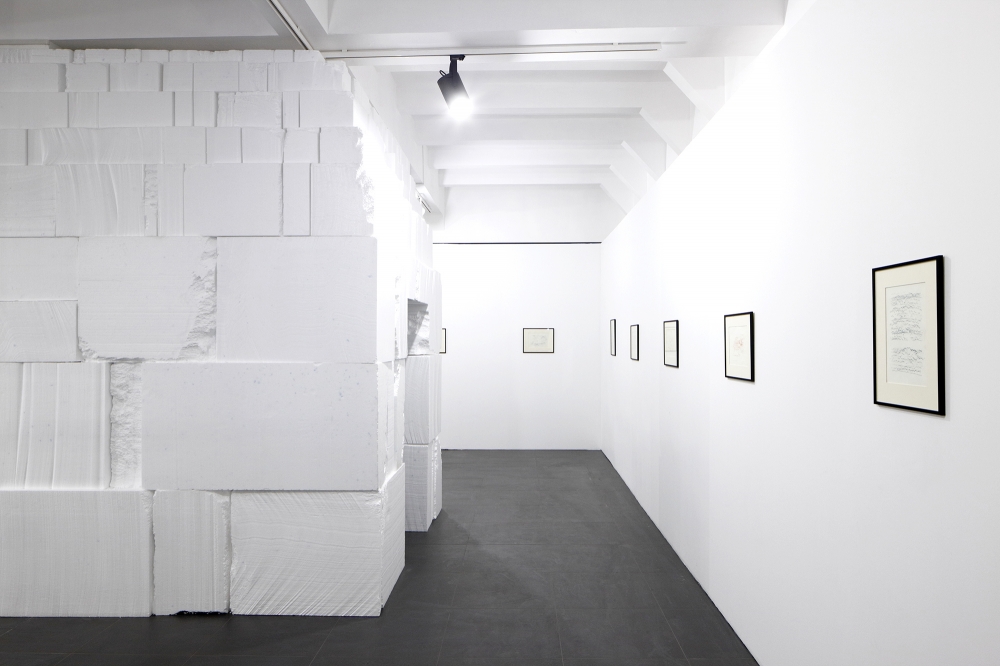
The Little Wailing Wall. 2018. Polystyrene, 650 cm x 250 cm x 320 cm, audio m4a 8:00 min, together with Error. Photo: Ansis Starks
The bureaucratization of the mind and trust in omnipotence teachings that refine illusions about leaders endowed with a mystical ability to pull out benefits of the Horn of Plenty inexhaustibly. Their own sleepy carelessness against the important, which made “professionals” more powerful than they should be. Their compromises. And what now...Reflection is the courage to question the truthfulness of knowledge and the space of its goals – it can be said not only by the philosopher Martin Heidegger but also by others, in particular context with Heidegger's intelligent sigh, that such "thinking is not necessary for everyone, and can be ineffective or even just unbearable". Miķelis Fišers new work exhibition can be read as the option that draws the reflection process: with a silence in almost uncontrollable outbursts in the series of colored pencil drawings or surrealistic frottages; with a "noisy" silence of almost unbearable, Dadaistic cries (voice by the artist), which stay “undressed“ even in the modern insulation material of The Little Wailing Wall (Floor II). And with the detailed narratives, full of illustrative material in large-scale paintings and with the precedent of narrative transformation from the visual matter to the textual one: the story, in its verbal intensity exceeding the painting potential, emanates from the painting as a "red thread" on the LED display (Floor I).
The observer from the distance can quite easily spot the extravaganza in Miķelis Fišers newest work. There are large paintings, new esoteric characters, and storylines, immersive and psychologically absorbing environments behind the figurative title “Blamescapes and Superflattenings”. There is a persistent narrative of morality in his work, though Miķelis Fišers chooses the language full of unscientific substances. Of all bodies of knowledge, he chooses knowledge without status and techniques of alternative criticality, which confirms the basic impact of science through deliberate unscientificity. With a power and with a weakness “Blamescapes and Superflattenings” challenges Heidegger's definition of the modern age: the world conceived and grasped as picture, and human beings transformed into subjectum, t.i., into the standard of everything existing. The technical clarity of the form and the message liked by the artist serves to provoke a doubt towards the "well-known" and to remind that the clearness about the world is not a consumer product that can be easily used. Miķelis Fišers purposefully uses the power of the art itself—it's being different from politics, philosophy, religion, science and esotericism, but trying to be in a conditional spatial point where the individual details of constructed fields lose their distinctions through their sharp edges. Striving to define its historical difference from art that was created before it, contemporary art has become careless in relation to the rest of the world. It’s starting to liken to everything else. Miķelis Fišers has taken this into consideration. He relies on and uses the distinctiveness of art as a point of departure of his conceptual work.
Artworks presented in the exhibition by Miķelis Fišers: “The Evil Message or the Last Sermon of Stringy Meatwinger”, “Sunrise at the Wastelands of Madness. Padites”, “The Abandoned Paradise” (all 2018, architecture by Roberta Fišere), Frottages of Polygonal Surfaces (2016), and “The Little Wailing Wall” (2018, sound together with ERROR). The full-length documentary by Mārtiņš Grauds ”Forging Condors” (2018) presented in the exhibition will help to lead to Miķelis Fišers art and personality.
Curator Inga Šteimane.(1) Martin Heidegger. Holzwege. Frankfurt am Main: Vittorio Klostermann, 1980. From: M. Heidegers. Malkasceļi. Rīga, Intelekts, 1998, 58.p., 71.p.
-
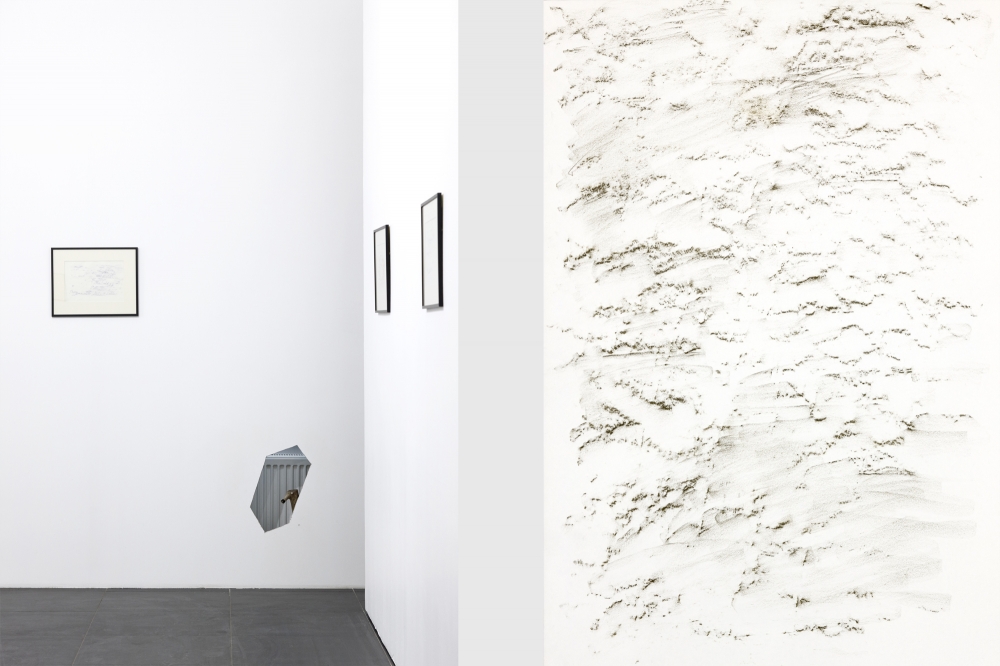
Miķelis Fišers. Frottages of Polygonal Surfaces. Peru, Bolivia. 2016. Pencil on paper, diorite. 20 cm x 29 cm. Twenty-one drawing. Photo: Ansis Starks
The bureaucratization of the mind and trust in omnipotence teachings that refine illusions about leaders endowed with a mystical ability to pull out benefits of the Horn of Plenty inexhaustibly. Their own sleepy carelessness against the important, which made “professionals” more powerful than they should be. Their compromises. And what now...Reflection is the courage to question the truthfulness of knowledge and the space of its goals – it can be said not only by the philosopher Martin Heidegger but also by others, in particular context with Heidegger's intelligent sigh, that such "thinking is not necessary for everyone, and can be ineffective or even just unbearable". Miķelis Fišers new work exhibition can be read as the option that draws the reflection process: with a silence in almost uncontrollable outbursts in the series of colored pencil drawings or surrealistic frottages; with a "noisy" silence of almost unbearable, Dadaistic cries (voice by the artist), which stay “undressed“ even in the modern insulation material of The Little Wailing Wall (Floor II). And with the detailed narratives, full of illustrative material in large-scale paintings and with the precedent of narrative transformation from the visual matter to the textual one: the story, in its verbal intensity exceeding the painting potential, emanates from the painting as a "red thread" on the LED display (Floor I).
The observer from the distance can quite easily spot the extravaganza in Miķelis Fišers newest work. There are large paintings, new esoteric characters, and storylines, immersive and psychologically absorbing environments behind the figurative title “Blamescapes and Superflattenings”. There is a persistent narrative of morality in his work, though Miķelis Fišers chooses the language full of unscientific substances. Of all bodies of knowledge, he chooses knowledge without status and techniques of alternative criticality, which confirms the basic impact of science through deliberate unscientificity. With a power and with a weakness “Blamescapes and Superflattenings” challenges Heidegger's definition of the modern age: the world conceived and grasped as picture, and human beings transformed into subjectum, t.i., into the standard of everything existing. The technical clarity of the form and the message liked by the artist serves to provoke a doubt towards the "well-known" and to remind that the clearness about the world is not a consumer product that can be easily used. Miķelis Fišers purposefully uses the power of the art itself—it's being different from politics, philosophy, religion, science and esotericism, but trying to be in a conditional spatial point where the individual details of constructed fields lose their distinctions through their sharp edges. Striving to define its historical difference from art that was created before it, contemporary art has become careless in relation to the rest of the world. It’s starting to liken to everything else. Miķelis Fišers has taken this into consideration. He relies on and uses the distinctiveness of art as a point of departure of his conceptual work.
Artworks presented in the exhibition by Miķelis Fišers: “The Evil Message or the Last Sermon of Stringy Meatwinger”, “Sunrise at the Wastelands of Madness. Padites”, “The Abandoned Paradise” (all 2018, architecture by Roberta Fišere), Frottages of Polygonal Surfaces (2016), and “The Little Wailing Wall” (2018, sound together with ERROR). The full-length documentary by Mārtiņš Grauds ”Forging Condors” (2018) presented in the exhibition will help to lead to Miķelis Fišers art and personality.
Curator Inga Šteimane.(1) Martin Heidegger. Holzwege. Frankfurt am Main: Vittorio Klostermann, 1980. From: M. Heidegers. Malkasceļi. Rīga, Intelekts, 1998, 58.p., 71.p.
